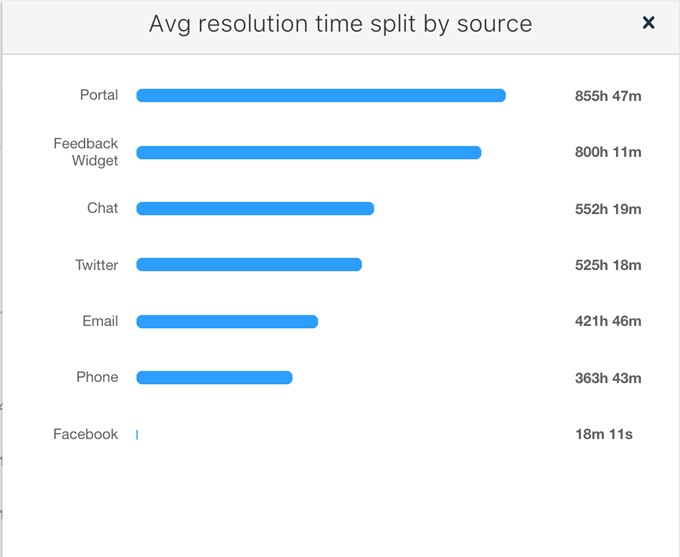Are you looking for ways to reduce the time it takes your company or organization to resolve customer problems? If so, then you’ve come to the right place. In this comprehensive blog post, we’ll talk about how you can decrease your average resolution time with actionable advice and strategies to help improve your customer service experience. Whether you are a small business or a larger corporation, these tips will allow you to respond quickly and effectively when faced with incidents that require attention. Let’s get started!
What is Average Resolution Time?
Tracking Average Resolution Time (ART) is a key way to make sure that your customer service agents get better over time and that customers are getting the support they need. With accurate measurements of ART, it’s easier to identify areas of improvement and compare how different agents are handling tickets.
Knowing the ART for each agent gives you an objective view that can be used as feedback for each team member. With information on ART at your fingertips, you’ll be able to help your teams continuously provide better customer service and gain insights into where more training or resources would be useful.
Why Is It Important For Startups To Track This Metric?
Tracking the average resolution time for customer inquiries is an essential component of any successful startup. It helps companies understand how quickly they’re responding to requests and allows them to identify potential issues before they become too costly to fix. For example, if a customer’s inquiry isn’t being responded to quickly enough, the company can act immediately to improve its response time.
This not only saves money but also keeps customers satisfied by providing prompt customer service. Additionally, tracking assesses performance and efficiency among customer service agents – leading to further improvements in response times. Keeping track of resolution times allows startups to assess the overall quality of their customer service while identifying areas where they can improve.
How do you calculate Average Resolution Time?
Here is the formula:
Total Resolution Time for all tickets solved / No. tickets solved = Average Resolution Time
If you’d like to get a better understanding of your team’s performance and efficiency, calculating your Average Resolution Time can help provide insight. All you need to do is divide up the total resolution time for all the tickets solved in the specified timeframe by the number of tickets that were solved. You can even make this calculation after removing any tickets marked as pending or on hold from the equation. Understanding your Average Resolution Time is essential for making sure your customer support operations remain fast and effective.
What factors affect Average Resolution Time?
Here are the effects of average resolution time:
Personnel
The number of personnel in the organization responsible for resolving customer issues will have a direct effect on the average resolution time. If there are fewer personnel, it may take longer to resolve an issue.
Processes
If processes used by personnel to resolve customer issues are not efficient or effective, this can significantly increase the average resolution time. If an organization has out of date or inefficient processes in place, it can take much longer to resolve customer issues.
Technology
Poor technology can also significantly increase the average resolution time. If an organization is relying on outdated software or hardware, this can result in slower resolutions times for customer issues.
Customer Interactions
The way an organization interacts with customers can also affect average resolution times. If customer interactions are poor or if customers don’t provide enough information to help resolve their issue, this can slow down the process and increase the average resolution time.
Problem Complexity
More complex issues naturally take longer to resolve than simpler issues. It is important to take into account the complexity of a customer’s issue when calculating the average resolution time.
Prioritization
The way an organization prioritizes customer issues can also affect resolution times. If certain issues are given higher priority and resolved quickly, this can pull down the average resolution time.
Training
If personnel are not adequately trained on how to resolve customer issues, this can also increase the average resolution time. It is important for personnel to be well-versed in the processes and technologies used in order to help resolve customer issues quickly.
By taking into account all of these factors, it is possible to make sure that the average resolution time is kept to a minimum. Organizations should take steps to ensure that all processes, technologies, and personnel are up-to-date in order to achieve optimal resolution times.
What is a good Average Resolution Time?
The ideal Average Resolution Time is usually within five minutes, meaning customers are satisfied with the wait time to receive a solution to their question. Generally, six minutes is considered an acceptable AHT (Average Handling Time) across numerous industries.
Industry Benchmark By Industry
The average target time for the resolution of all kinds of issues across all industries is less than 8:30 minutes. Recent data on performance standards vary depending on the industry, but when it comes to mean time to resolution benchmarks, the results are promising.
- All industries: under 8:30 minutes
- Retail and eCommerce: under 6 minutes
- Services: under 9 minutes
- Shipping and logistics: under 4 minutesAv
- Telecommunications: under 9 minutes
- Financial services and banking: under 5 minutes
Average resolution time split by Source
This graph displays the average time taken to solve tickets from different sources during the chosen timeframe. By analyzing it, you can identify the source that has the longest resolution time and investigate what is causing the delay.

Average resolution time split by Priority
The chart illustrates the average resolution time for tickets of various priorities in the chosen time frame. It is expected that the average resolution time should decrease as the priority level increases.
How to Decrease Your Average Resolution Time?
Let’s check out how to decrease average resolution time:
Define the Process:
Before attempting to reduce your resolution time, it’s important to have a clear understanding of how you resolve customer issues in the first place. What are all the steps involved? Who is responsible for each step? How quickly do they need to be completed? Having these answers up front will help you identify potential bottlenecks and develop a plan to address them.
Automate Repetitive Tasks
Automation can be a great way to reduce resolution time. For example, if you have a customer support team that is dealing with the same types of inquiries each day, an automated chatbot could help take some of those issues off their plate. Additionally, automated workflows can be used to streamline the process for complex issues.
Train Your Team
To reduce resolution time, it’s important that your team members are knowledgeable about the products and services you offer and how to resolve common customer inquiries quickly and efficiently. Investing in training sessions or even one-on-one coaching can make a big difference in how quickly they are able to resolve customer issues.
Invest in Tools
Having the right tools can help reduce resolution time significantly. This could include anything from customer feedback surveys to management tools that allow you to track and report on resolutions quickly and easily. Investing in quality tools will ensure that your resolution time is as efficient as possible.
Monitor Your Progress
As you strive to reduce your resolution time, it’s important to track your progress and identify any potential areas of improvement. Set up a system that allows you to monitor resolution times for each customer issue and use this data to make adjustments where necessary.
These are just a few of the ways you can reduce your average resolution time. Taking the time to evaluate and optimize your process will help ensure that your customers have a positive experience with your customer service team. With these tips, you’ll be well on your way to decreasing resolution times and providing better service to your customers.
Tools To Measure Average Resolution Time
Measuring average resolution time is an essential part of managing customer support operations. It helps you identify areas that require improvement, and also enables you to compare your performance against industry standards.
There are several tools available that can help you measure the average resolution time of your customer service team. These include:
Support Ticketing Systems:
Support ticketing systems are the most common tool used to track customer service tickets. By monitoring when a ticket is opened and closed, you can measure how long it takes for your team to resolve an issue.
Call Logging Systems:
For teams using phone support, call logging systems to allow you to capture data about customer calls, such as duration and resolution time. By analyzing this data, you can identify areas that need improvement.
Customer Satisfaction Surveys:
Customer satisfaction surveys are a great way to measure average resolution time because they provide direct feedback from customers about how satisfied they were with the service they received.
By using these tools to measure average resolution time, you can ensure your customer service team is performing to the highest standards. Additionally, you will be able to track progress and adjust strategies to better meet customer needs.
Conclusion
In conclusion, decreasing your average resolution time is a matter of focusing on the root cause of customer pain points and addressing them directly. By following the steps we’ve outlined in this blog post, you can decrease your average resolution time and improve customer satisfaction.

